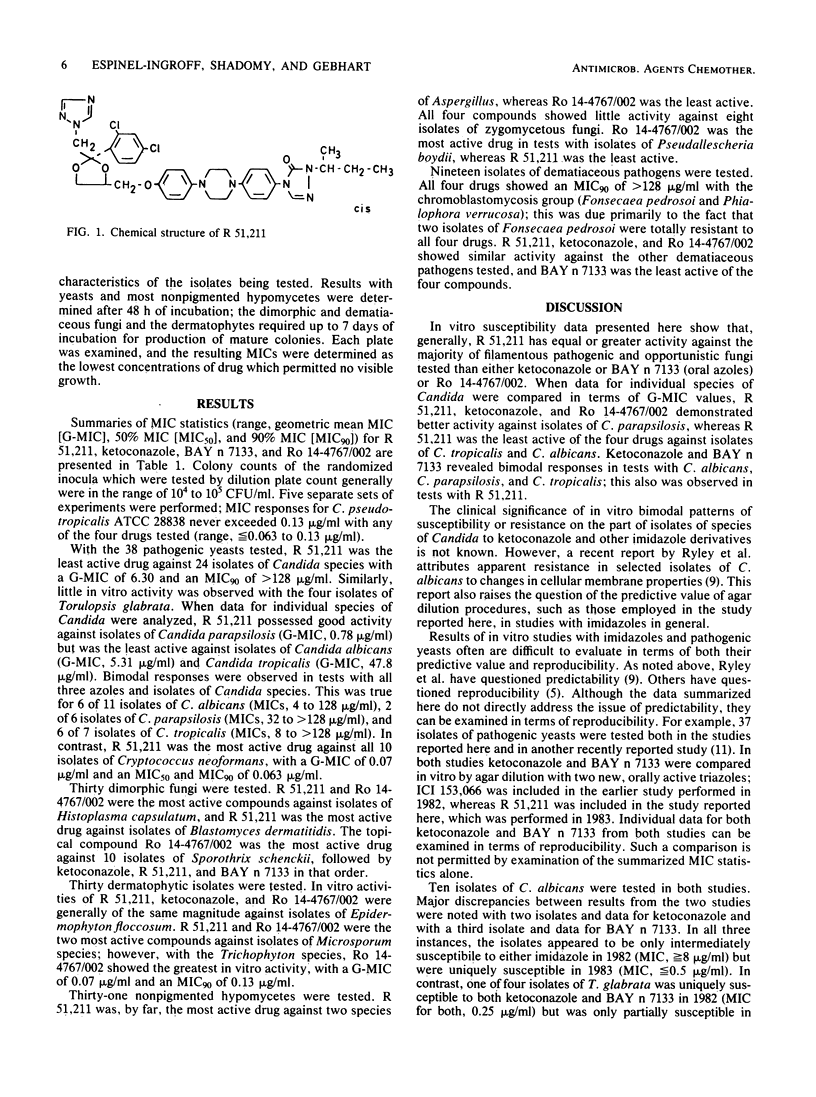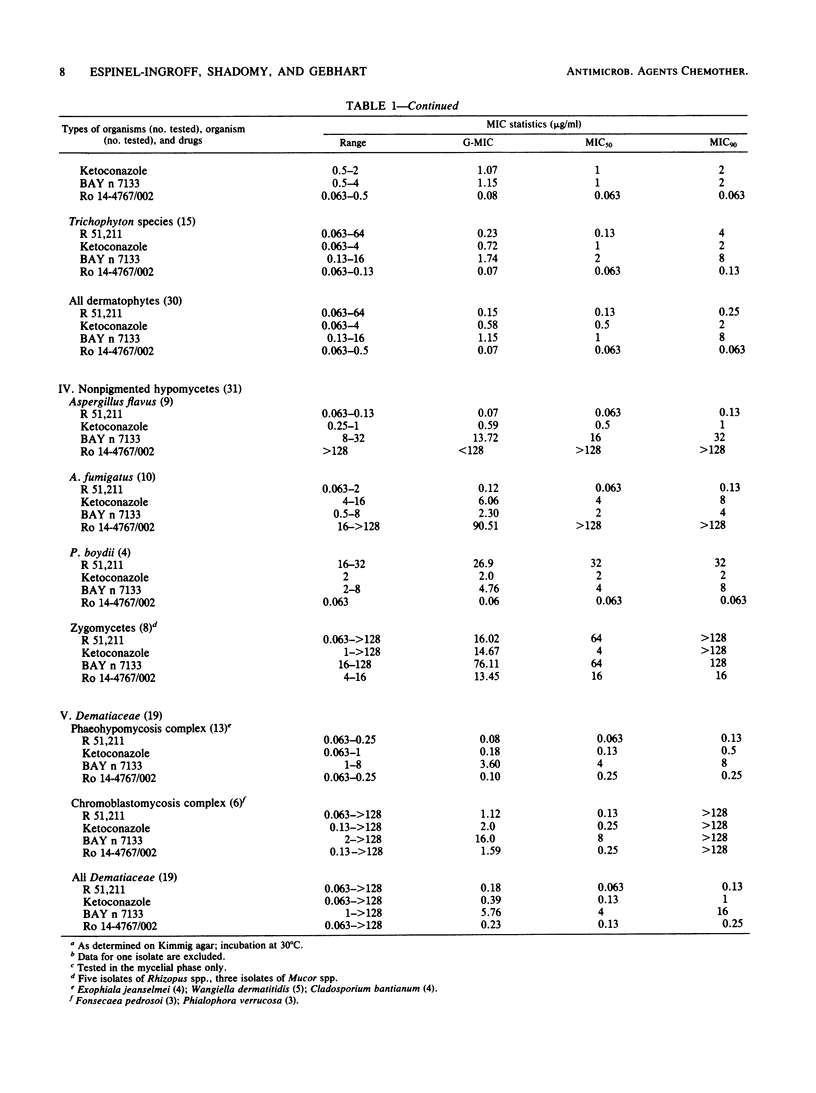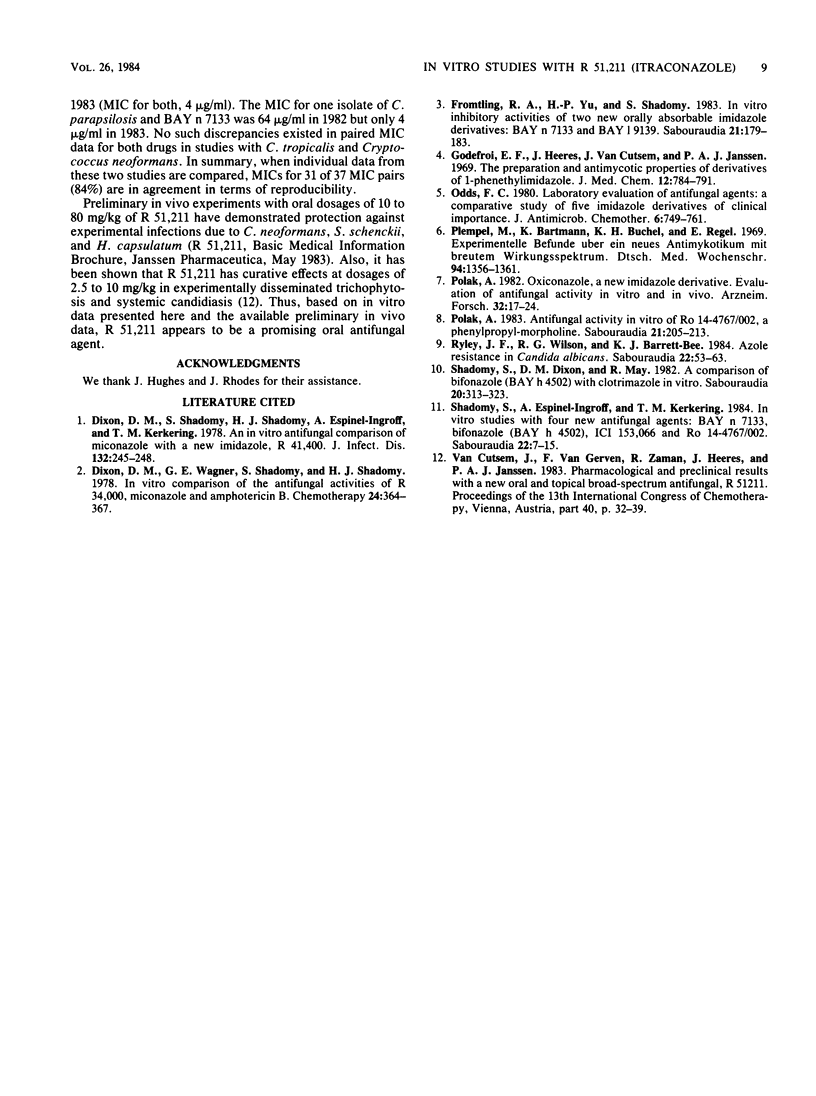Abstract
The in vitro activity of R 51,211 (itraconazole, accepted generic name; Janssen Pharmaceutica, Beerse, Belgium), a new orally active triazole, was compared with those of two existing orally active azoles, ketoconazole and BAY n 7133, and a topical agent, Ro 14-4767/002. An agar dilution procedure (Kimmig agar) was performed with 148 isolates of pathogenic fungi. Incubation was at 30 degrees C from 48 h to 7 days. R 51,211 was dissolved in 0.2 N HCl in absolute ethanol, ketoconazole was dissolved in 0.2 N HCl alone, BAY n 7133 was dissolved in absolute ethanol, and Ro 14-4767/002 was dissolved in dimethyl sulfoxide. R 51,211 and Ro 14-4767/002 were the most active drugs against isolates of Histoplasma capsulatum, and R 51,211 showed the greatest activity in vitro against isolates of Blastomyces dermatitidis and Cryptococcus neoformans. Ro 14-4767/002 was the most active drug against 30 isolates of dermatophytes, followed by R 51,211, ketoconazole, and BAY n 7133. R 51,211 showed the best activity in vitro against 19 isolates of Aspergillus fumigatus and Aspergillus flavus, as well as 19 isolates of dematiaceous fungi. All four drugs had 90% MICs of greater than or equal to 16 micrograms/ml when tested with isolates of zygomycetous fungi.
Full text
PDF




Selected References
These references are in PubMed. This may not be the complete list of references from this article.
- Dixon D. M., Wagner G. E., Shadomy S., Shadomy H. J. In vitro comparison of the antifungal activities of R34,000, miconazole and amphotericin B. Chemotherapy. 1978;24(6):364–367. doi: 10.1159/000237809. [DOI] [PubMed] [Google Scholar]
- Dixon D., Shadomy S., Shadomy H. J., Espinel-Ingroff A., Kerkering T. M. Comparison of the in vitro antifungal activities of miconazole and a new imidazole, R41,400. J Infect Dis. 1978 Aug;138(2):245–248. doi: 10.1093/infdis/138.2.245. [DOI] [PubMed] [Google Scholar]
- Fromtling R. A., Yu H. P., Shadomy S. In-vitro inhibitory activities of 2 new orally absorbable imidazole derivatives: BAY n 7133 and BAY 1 9139. Sabouraudia. 1983 Sep;21(3):179–184. doi: 10.1080/00362178385380291. [DOI] [PubMed] [Google Scholar]
- Godefroi E. F., Heeres J., Van Cutsem J., Janssen P. A. The preparation and antimycotic properties of derivatives of 1-phenethylimidazole. J Med Chem. 1969 Sep;12(5):784–791. doi: 10.1021/jm00305a014. [DOI] [PubMed] [Google Scholar]
- Odds F. C. Laboratory evaluation of antifungal agents: a comparative study of five imidazole derivatives of clinical importance. J Antimicrob Chemother. 1980 Nov;6(6):749–761. doi: 10.1093/jac/6.6.749. [DOI] [PubMed] [Google Scholar]
- Plempel M., Bartmann K., Büchel K. H., Regel E. Experimentelle Befunde über ein neues, oral wirksames Antimykotikum mit breiten Wirkungsspektrum. Dtsch Med Wochenschr. 1969 Jun 27;94(26):1356–passim. doi: 10.1055/s-0028-1111223. [DOI] [PubMed] [Google Scholar]
- Polak A. Antifungal activity in vitro of Ro 14-4767/002, a phenylpropyl-morpholine. Sabouraudia. 1983 Sep;21(3):205–213. [PubMed] [Google Scholar]
- Polak A. Oxiconazole, a new imidazole derivative. Evaluation of antifungal activity in vitro and in vivo. Arzneimittelforschung. 1982;32(1):17–24. [PubMed] [Google Scholar]
- Ryley J. F., Wilson R. G., Barrett-Bee K. J. Azole resistance in Candida albicans. Sabouraudia. 1984;22(1):53–63. [PubMed] [Google Scholar]
- Shadomy S., Dixon D. M., May R. A comparison of bifonazole (BAY H 4502) with clotrimazole in vitro. Sabouraudia. 1982 Dec;20(4):313–323. [PubMed] [Google Scholar]
- Shadomy S., Espinel-Ingroff A., Kerkering T. M. In-vitro studies with four new antifungal agents: BAY n 7133, bifonazole (BAY h 4502), ICI 153,066 and Ro 14-4767/002. Sabouraudia. 1984;22(1):7–15. doi: 10.1080/00362178485380041. [DOI] [PubMed] [Google Scholar]


